Immunoglobulin M
Introduction
Immunoglobulin M (IgM) is one of the several forms of antibodies that are produced by the immune system to fight against foreign substances such as pathogens. It is the first antibody to be produced in response to an antigen, and plays a crucial role in the primary immune response.


Structure and Properties
IgM is a large molecule, with a pentameric structure that consists of five monomeric units linked together. Each monomer is composed of two heavy chains (μ chains) and two light chains, and is connected to the other monomers through disulfide bonds and a joining (J) chain. This unique structure allows IgM to bind up to 10 antigens simultaneously, making it highly effective in agglutination and neutralization of pathogens.
Function
IgM plays a vital role in the immune response. It is the first antibody to be produced following exposure to an antigen, and its levels peak within a week of initial exposure. It is primarily found in the blood and lymph fluid, where it binds to pathogens and neutralizes them. IgM also activates the complement system, a group of proteins that work together to destroy pathogens, and enhances the phagocytosis of pathogens by phagocytes.
Clinical Significance
The presence of IgM in the blood is often used as an indicator of recent infection, as it is the first antibody to be produced in response to an antigen. High levels of IgM can indicate an ongoing or recent infection, while low levels can indicate an immune deficiency or a more chronic infection. IgM is also involved in some autoimmune diseases, where it mistakenly targets the body's own cells.
